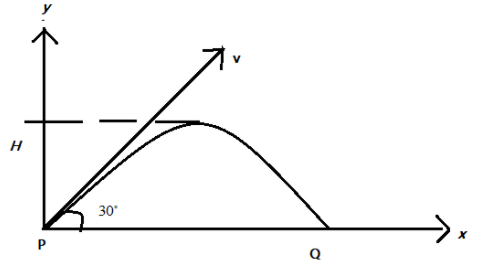
A projectile of mass $m$ is fired with velocity $v$ from a point as shown in figure, neglecting air resistance, what is the change in momentum when leaving $P$ and arriving at $Q$?

\[\begin{align}
& A.0 \\
& B.mv \\
& C.4mv \\
& D.\dfrac{2mv}{\sqrt{3}} \\
\end{align}\]

Answer
571.2k+ views
Hint: A body experiences a projectile motion when the object is projected at an inclination from the ground. Then the body follows a curved path, which is parabolic in nature and is called the ballistic trajectory. Then the distance covered by the body along the x and y-axis respectively is given as, $R$ and $H$ which is the maximum horizontal range and maximum height attained by the object.
Formula:
$m\Delta v=mu-mv$
Complete answer:
We know that momentum $p$ is a quantity which describes the state of the object. It is given as $p=mv$ where $m$ is the mass of the object and $v$ is the velocity of the object.
We know that projectile motion has two components, namely the x and y components
Then, we can express the components of velocity $v$ as \[v\cos 30\] along the x-axis and \[v\sin 30\] along the y-axis.
Now to find the change in momentum along \[PQ\], we can ignore the horizontal constant as it remains the same throughout the along \[PQ\]. Then clearly, as \[PQ\] is along the vertical component, there is change in momentum along the vertical direction.
Then the change in momentum is given as, $m\Delta v=mu-mv$ . Here, the final velocity is the negative of the initial velocity. Then we get, $m\Delta v=mv sin 30-(-mv sin 30)=2mv\dfrac{1}{2}=mv$
Hence the answer is \[B.mv\]
Note:
When the object is on the air, the only force acting on the body is the force due to gravitation, which pulls the object back to the surface at the speed of acceleration due to gravity. Note that the range of the projected body is greater than the distance the body will cover, when dropped from the same height.
Formula:
$m\Delta v=mu-mv$
Complete answer:
We know that momentum $p$ is a quantity which describes the state of the object. It is given as $p=mv$ where $m$ is the mass of the object and $v$ is the velocity of the object.
We know that projectile motion has two components, namely the x and y components
Then, we can express the components of velocity $v$ as \[v\cos 30\] along the x-axis and \[v\sin 30\] along the y-axis.
Now to find the change in momentum along \[PQ\], we can ignore the horizontal constant as it remains the same throughout the along \[PQ\]. Then clearly, as \[PQ\] is along the vertical component, there is change in momentum along the vertical direction.
Then the change in momentum is given as, $m\Delta v=mu-mv$ . Here, the final velocity is the negative of the initial velocity. Then we get, $m\Delta v=mv sin 30-(-mv sin 30)=2mv\dfrac{1}{2}=mv$
Hence the answer is \[B.mv\]
Note:
When the object is on the air, the only force acting on the body is the force due to gravitation, which pulls the object back to the surface at the speed of acceleration due to gravity. Note that the range of the projected body is greater than the distance the body will cover, when dropped from the same height.
Recently Updated Pages
Master Class 11 Economics: Engaging Questions & Answers for Success

Master Class 11 English: Engaging Questions & Answers for Success

Master Class 11 Social Science: Engaging Questions & Answers for Success

Master Class 11 Biology: Engaging Questions & Answers for Success

Class 11 Question and Answer - Your Ultimate Solutions Guide

Master Class 11 Business Studies: Engaging Questions & Answers for Success

Trending doubts
10 examples of friction in our daily life

One Metric ton is equal to kg A 10000 B 1000 C 100 class 11 physics CBSE

Difference Between Prokaryotic Cells and Eukaryotic Cells

1 Quintal is equal to a 110 kg b 10 kg c 100kg d 1000 class 11 physics CBSE

Explain zero factorial class 11 maths CBSE

What is a periderm How does periderm formation take class 11 biology CBSE




